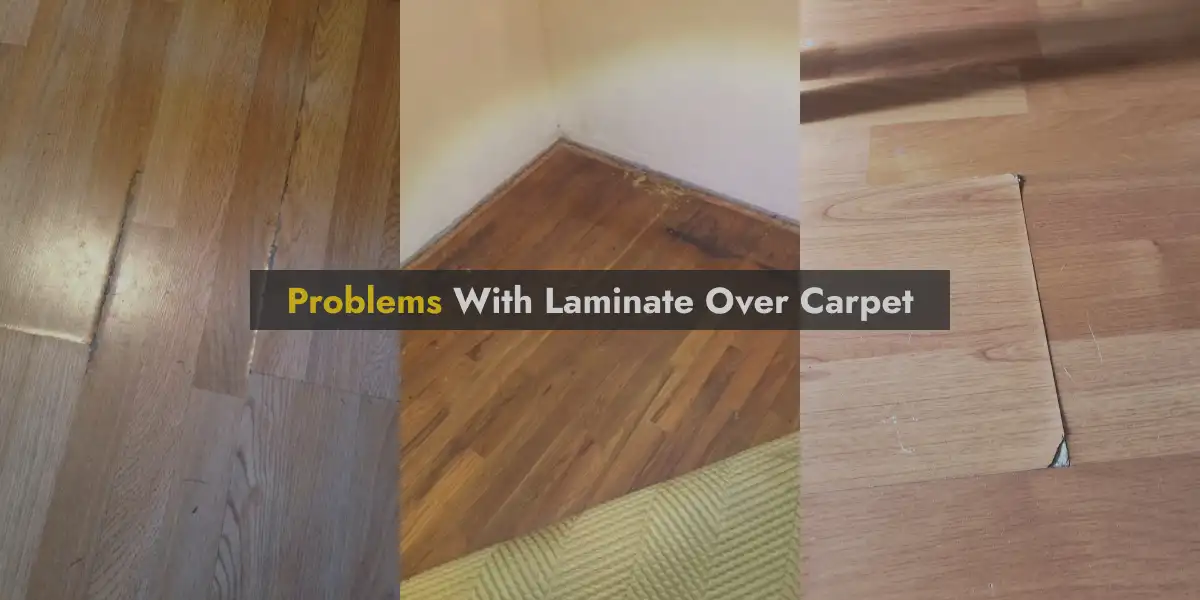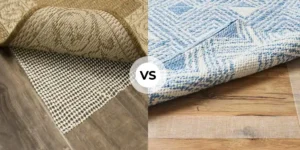Are you thinking of decorating your home with some interesting flooring? Well, it is a great move. For your needs, laminate flooring can be a perfect choice.
Because it is easy to install and maintain, as well as built to last. So, it has become a top choice for homeowners.
Laminate flooring has many benefits, but consider its limitations and choose appropriate spaces. Avoid installing laminate in high-moisture areas such as bathrooms, laundry rooms, and basements.
Are you thinking of laying laminate over your existing carpet? Well, you should think twice before doing this. Why? Because it is not recommended.
One big issue is the uneven surface. This is caused by the carpet, which can lead to your lovely laminate buckling. Plus, these problems can harm your laminate floors.
To put it simply, if you’re considering laminate, you should get rid of your carpet first.
Now, you might be wondering why some people choose to keep both carpet and laminate, right? Well, we’re here to answer your questions and explain why it’s not always the best choice. So, let’s learn.
You Might Also Like:
- Can You Install Laminate Flooring Over the Carpet? (9 Easy Steps)
- Can You Put Vinyl Flooring Over the Carpet? (9 Easy Steps)
Why Do Some Homeowners Choose to Install Laminate Flooring Over Carpet?
Homeowners choose to install laminate flooring over carpets for some practical reasons.
Firstly, it’s a budget-friendly move. Laminate flooring is cheaper than carpeting and it is easier to install and maintain.
Secondly, laminate flooring tends to be tougher and simpler to keep in tip-top shape. It’s a good choice for those who have allergies and it can handle spills like a champ.
Also, you can experiment with different styles and textures without changing your room.
So, if you’re the creative type, you’ll love the extra design flexibility. You can easily mix and match colors and patterns to create a one-of-a-kind look for your home.
Laminate Flooring Over Carpet Problems and Solutions
#1 Uneven Surface
When you install laminate flooring over carpet, its fabrics become uneven over time. After some time, you will notice that some areas of the laminate floor are lower than others. Moreover, the uneven surface of the carpet causes this problem.
There’s a reason why things get uneven under laminate flooring when you use high-pile carpets.
High-pile carpets have taller, looser fibers that just don’t work with laminate. It’s the extra weight from those high-pile carpets that causes the unevenness over time.
Solution: The solution to uneven surfaces is to apply a low-pile carpet underneath. Because low-pile carpet smooths out bumps and ridges. Besides, it absorbs sound and reduces noise in homes and offices.
#2 Buckling and Wrapping
Bucking and warping of laminate flooring is caused by humidity and temperature changes.
It can cause the flooring to expand and contract, resulting in gaps and buckling. Its main reasons are improper installation, poor subfloor preparation, and furniture movement.
All these factors can cause the laminate flooring to buckle and wrap.
Solution: Removing the carpet and installing a laminate floor is the best move to solve these issues. Plus, it is necessary to secure the floor planks to the bottom to prevent buckling and wrapping.
#3 Reduced Stability
When you put laminate on top of the carpet, you’re setting yourself up for more trouble.
See, carpet doesn’t give you the sturdy foundation that hardwood does. Plus, it’s like a magnet for dirt and moisture, which can mess with your lovely laminate floors.
Because it’s got this wood fiberboard at the bottom and a laminate layer on top.
The problem is, over time, wood fiberboard can start warping and curling. Plus, it’s like a sponge when it comes to moisture, so it’s not the best bet for your home.
Solutions: Laminate flooring’s stability can be reduced by underlayment. As a result, this layer cushions the flooring, reducing vibration and noise. Also, the underlayment layer keeps the floor warmer in winter and cooler in summer.
#4 Moisture and Mold Issues
Putting laminate on top of the carpet can be a recipe for moisture and mold problems. You see, carpets have a knack for locking in moisture.
The main reason for moisture and mold issues is the lack of air circulation and ventilation.
This problem can occur when laminate flooring is installed over the carpet. Additionally, moisture from the carpet can seep through and damage the laminate.
Solution: You can avoid this by drying out your carpet and subfloor before installing it. Plus, a good underlayment gives your floor extra support and protection. And don’t forget a moisture barrier.
#5 Reduced Laminate Lifespan
Yes, when you install laminate flooring over carpet, it can shorten the lifespan of your flooring.
Laminate flooring can act up for several reasons. If the subfloor underneath isn’t flat and stable, the laminate will flex and buckle over time. Which isn’t good for its long-term health.
Plus, if water gets into the mix and it isn’t installed properly, it can go south as well. When the laminate is damaged by water, the surface will become uneven and unstable.
Solution: To solve these issues with laminate flooring, remove the carpet and install it. But remember, you should install it on a solid and leveled subfloor. If the subfloor is not stable and level, it must be leveled before installation.
#6 Scratches and Stains
Scratches and stains can hamper the appearance of laminate flooring over carpet. These scratches and stains can be caused by pets, furniture, and other wear and tear.
Liquid spills, pet accidents, or other stains can seep into the carpet and reach the laminate flooring underneath.
And it causes discoloration or damage to the laminate surface. Also, nail scratches and other sharp objects can scratch laminate flooring.
Solution: A microfiber cloth is the best solution for removing scratches from laminate flooring. Also, microfiber cloths are less likely to scratch laminate than harsher cloths.
#7 Crack and Gaps
Laminate flooring will eventually crack or gap if installed over carpeting. In some cases, the gaps become so large that the entire flooring cracks.
Moreover, the carpet expands as it absorbs moisture, causing cracks. When you put laminate flooring on top of the carpet, you might notice some cracks and gaps showing up.
That’s because the carpet underneath can wiggle around, making the laminate all wonky. Plus, it’s a dust magnet, and that’s not good news for your laminate’s looks.
Solution: Before laminate installation begins, please take a look at the subfloor and for any subtle cracks or gaps. And once that’s all good, put on some adhesive to lock the laminate in place. Also, you should use spacers during installation to ensure consistent gap spacing.
What type of Carpet is Most Effective for Laminate Flooring?
If you’ve got laminate floors and are wondering what carpet to choose, go for one that has a low pile or minimal padding.
In this way, you can be sure that your laminate will remain in top condition and will not get damaged. Plus, it’s great at keeping dirt and dust from piling up on your floors.
Check Out More Related to Laminate Floorings:
- Can You Put Vinyl Flooring Over the Carpet? (9 Easy Steps)
- Can I Use Laminate Flooring On Walls? (Installation Guide Included)
- 6 Best Ways to Fix Dents in Laminate Flooring (Tried & Tested)
- The Best Laminate Flooring Cleaning Hacks: Top 7





